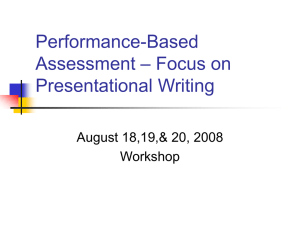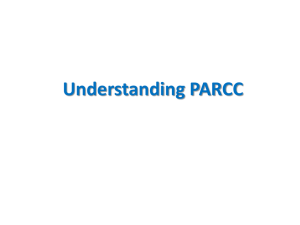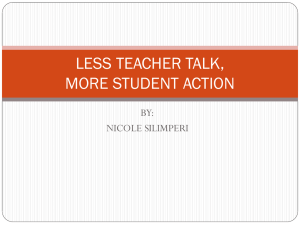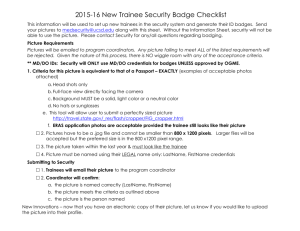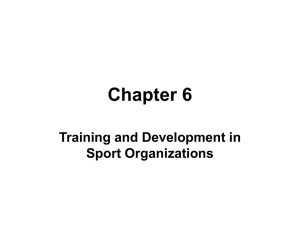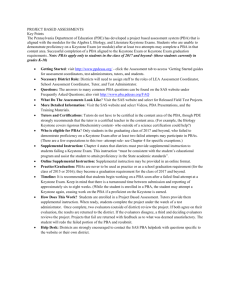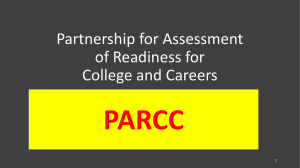(DOCX, 173B) - British Orthopaedic Association
advertisement
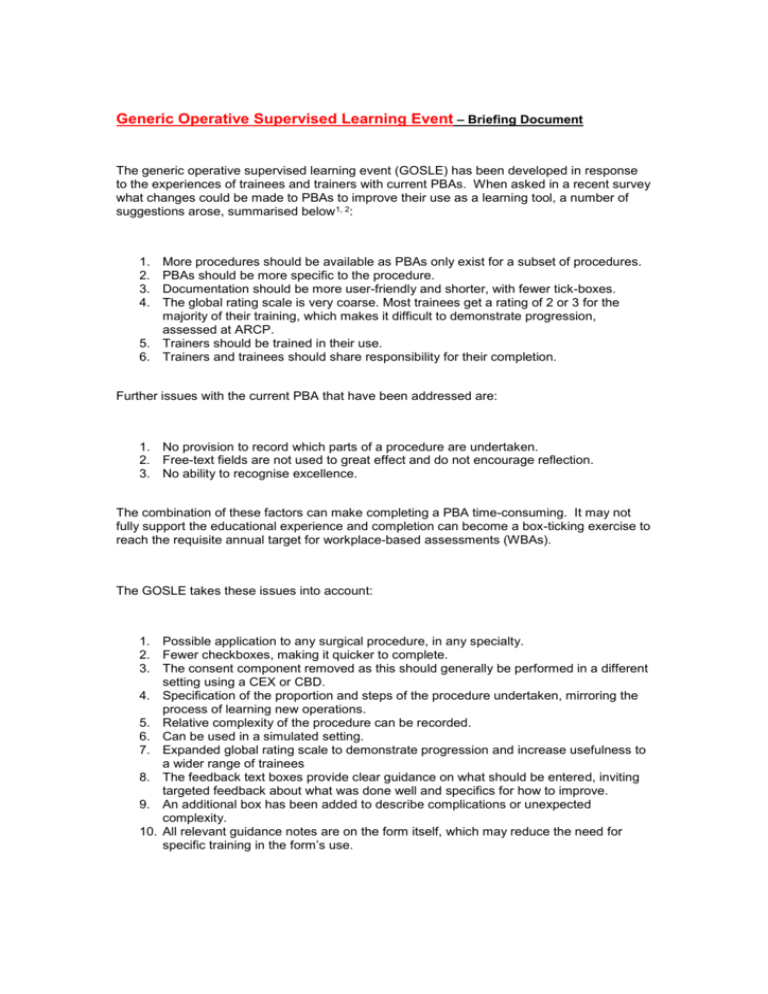
Generic Operative Supervised Learning Event – Briefing Document The generic operative supervised learning event (GOSLE) has been developed in response to the experiences of trainees and trainers with current PBAs. When asked in a recent survey what changes could be made to PBAs to improve their use as a learning tool, a number of suggestions arose, summarised below1, 2: 1. 2. 3. 4. More procedures should be available as PBAs only exist for a subset of procedures. PBAs should be more specific to the procedure. Documentation should be more user-friendly and shorter, with fewer tick-boxes. The global rating scale is very coarse. Most trainees get a rating of 2 or 3 for the majority of their training, which makes it difficult to demonstrate progression, assessed at ARCP. 5. Trainers should be trained in their use. 6. Trainers and trainees should share responsibility for their completion. Further issues with the current PBA that have been addressed are: 1. No provision to record which parts of a procedure are undertaken. 2. Free-text fields are not used to great effect and do not encourage reflection. 3. No ability to recognise excellence. The combination of these factors can make completing a PBA time-consuming. It may not fully support the educational experience and completion can become a box-ticking exercise to reach the requisite annual target for workplace-based assessments (WBAs). The GOSLE takes these issues into account: 1. Possible application to any surgical procedure, in any specialty. 2. Fewer checkboxes, making it quicker to complete. 3. The consent component removed as this should generally be performed in a different setting using a CEX or CBD. 4. Specification of the proportion and steps of the procedure undertaken, mirroring the process of learning new operations. 5. Relative complexity of the procedure can be recorded. 6. Can be used in a simulated setting. 7. Expanded global rating scale to demonstrate progression and increase usefulness to a wider range of trainees 8. The feedback text boxes provide clear guidance on what should be entered, inviting targeted feedback about what was done well and specifics for how to improve. 9. An additional box has been added to describe complications or unexpected complexity. 10. All relevant guidance notes are on the form itself, which may reduce the need for specific training in the form’s use. It would be useful in future to integrate the GOSLE with the logbook so assessments can link directly to procedures and supplement the SAC guidance that trainees need to log a minimum of 1800 cases prior to CCT, as a further layer of quality control. A form that is quicker and more useful to complete may help shift us to a culture of formatively assessing most procedures, rather than being forced to select only procedures that are included in the PBA list. Trainers should be more likely to initiate an assessment leading to regular structured feedback on performance and consequently improve the quality of training. While the generic DOPS allows any procedure to be assessed, similar problems arise including too many inappropriate fields and a coarse global rating. GOSLE Pilot: AO Course Basingstoke November 2012 A pilot study of the GOSLE was undertaken at an AO Principles course. Its aims were to: 1. Obtain feedback about the ease-of-use and acceptability of the GOSLE from trainers and trainees 2. Determine how the GOSLE could be improved 3. Compare the quality of feedback in the PBA and the GOSLE Course delegates had their performance of various fixation techniques assessed using a mix of PBAs and GOSLEs. Faculty and delegates completed a questionnaire relating to the assessment methods. Responses were received from 25 delegates and 12 faculty members. Overall, trainees were positive about the GOSLE (figure 1), and trainers even more so (figure 2). Trainee Opinions about GOSLE 0% 20% 40% 60% 80% 100% Easy to use Strongly Agree Good for Feedback Agree Neutral Global Rating Easy to Understand Global Rating good Discriminator Figure 1. Trainee experiences of the GOSLE. Disagree Strongly Disagree High Volume Trainee Opinions about GOSLE 0% 20% 40% 60% 80% 100% Easy to use Strongly Agree Good for Feedback Agree Neutral Global Rating Easy to Understand Disagree Strongly Disagree Global Rating good Discriminator Figure 2. Trainer experiences of the GOSLE. Figures 3 and 4 indicate trainees’ and trainers’ preferences between the PBA and GOSLE. The majority of trainees preferred the GOSLE or had no preference, with relatively few preferring the PBA. Conversely, there is very strong support for the GOSLE by trainers. Trainee Preferences 0% 10% 20% 30% 40% 50% 60% 70% 80% 90% 100% Feedback Tool Demonstrates Progression GOSLE Neutral Quicker to Complete Preferred Overall Figure 3. Trainee comparison between GOSLE and PBA. PBA Trainer Preferences 0% 20% 40% 60% 80% 100% Feedback Tool Demonstrates Progression GOSLE Neutral PBA Quicker to Complete Preferred Overall Figure 4. Trainer comparison between GOSLE and PBA. The quality of feedback in each of the available feedback boxes was categorised as either: Descriptive: only descriptive comments, such as ‘simulated procedure’ General Feedback: comments such as ‘well done’ Specific Feedback: specific advice such as ‘aim for a better reduction’ or ‘good guide wire positioning’ No feedback given Approximately 50% of PBA feedback areas contained no feedback, and when given, it was often non-specific (figure 5). Conversely, 90% of GOSLE feedback areas contained feedback (figure 6) and it was usually specific. ISCP PBA Feedback Boxes 0% 10% 20% 30% 40% 50% 60% 70% 80% 90% 100% Comments Descriptive Conclusions General Specific None Actions Figure 5. PBA Feedback Box Content GOSLE Feedback Boxes 0% 10% 20% 30% 40% 50% 60% 70% 80% 90% 100% Good Performance Descriptive General Specific None Improvement Figure 6. GOSLE Feedback Box Content In summary, this pilot study demonstrated that trainees and trainers are positive about the GOSLE. Higher-quality feedback was given for the GOSLE. We would hope that this translates to better engagement with workplace-based assessment if it were to be adopted. In almost all instances, the GOSLE is preferred to the PBA. Whilst the GOSLE is not intended to replace the PBA, it appears to better support formative feedback for any procedure performed. The GOSLE can therefore be used to complement the PBA, which is a much more structured and prescriptive tool that lends itself to summative assessment of performance. This can reduce trainee anxieties about the dichotomy of formative and summative assessment that affects the PBA. Validation Following the pilot study, we believe that the GOSLE is ready for a larger-scale trial. Two distinct features of the form require validation. 1. The global rating 2. User satisfaction and acceptability, which is crucial for a tool that is supposed to be high-volume. There are three proposed arms of the study: 1. Workplace-based study to determine feasibility, acceptability and performance of the tool. A limited number of consultants and trainees have been using this assessment and feedback has been universally positive. However, this is a selfselected sample and to avoid this sampling bias, we would like to undertake a larger-scale trial of orthopaedic trainees. 2. Videotaped procedures performed by different levels of trainee which can then be distributed and graded. This will assess the reliability of the global rating scale. It could be combined with a parallel rating using the PBA. 3. Simulated procedures ‘scripted’ to different levels of performance to determine the accuracy of the global rating scale and construct validity. Several previous trials have reported on validation of the PBA3, 4. They have used generalisability theory to assess reliability and similar methodology can be employed. Recruitment has been difficult for the workplace-based trial as the GOSLE is regarded as another assessment in addition to the 40 WBA target without any material benefit from trainees. If SAC approval can be granted to allow GOSLEs to be counted toward the 40 WBA target for a trial period, there will be no difficulty in finding volunteers. This will also improve the validity of the results as it will emphasise equivalence with other forms of assessment and reduce selection bias. Note: The GOSLE can be tested online at test@test.com and password is 123. www.gosle.co.uk The username is RM Davies ST4 Trauma & Orthopaedics North Western Deanery PG Turner Consultant Orthopaedic Surgeon & Head of School of Surgery North Western Deanery L Hadfield-Law British Orthopaedic Association Education Advisor References 1. Hunter A. Unpublished Data. 2012. 2. BOTA. Position Statement: Procedure Based Assessments in Orthopaedics and Trauma: British Orthopaedic Trainees' Association; 2012. 3. Beard JD, Marriott J, Purdie H, Crossley J. Assessing the surgical skills of trainees in the operating theatre: a prospective observational study of the methodology. Health Technol Assess. 2011; 15(1): i-xxi, 1-162. 4. Marriott J, Purdie H, Crossley J, Beard JD. Evaluation of procedure-based assessment for assessing trainees' skills in the operating theatre. The British Journal of Surgery. 2011; 98(3): 450-7.
